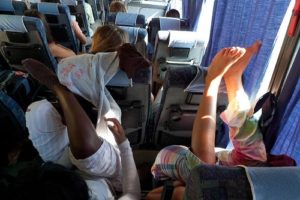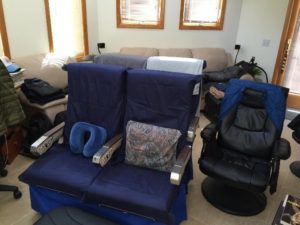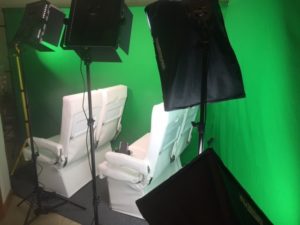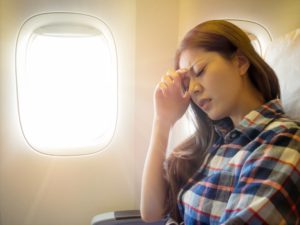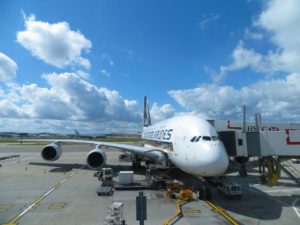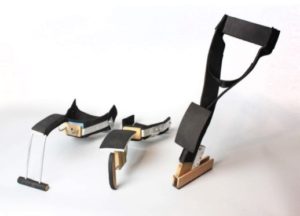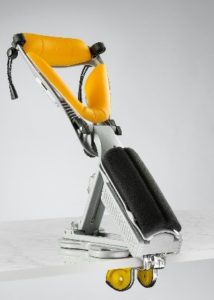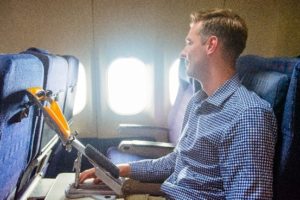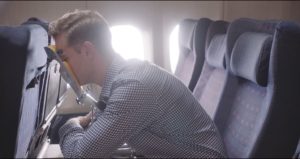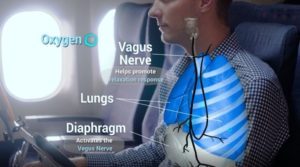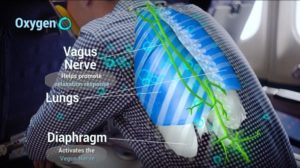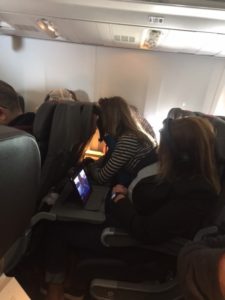By Chloe Hill
Passenger planes today just don’t seem to be designed for, well, passengers. A ticket gets you a not-so-spacious seat….. sometimes only 17 by 24 inches. Yes, a space smaller than some dog kennels. In fact, your Labrador retriever in the cargo hold may have more room to move around.
There you are, sitting upright for 3, 6, 13 hours in seats that are designed to cram more passengers on a flight, rather than with your comfort in mind. Demonstrating how airlines have changed seats to accomplish this goal, we bought some old Southwest Airline seats from the 1990s for testing purposes, and boy are they comfortable in comparison — nice thick and supportive cushions as oppose to the thinly padded cushions found on today’s airplane seats!
Southwest Airlines airplane seats from 1990s in Darryl’s living room Reupholstered SW Airlines airplane seats
One might argue however, that even more of a barrier to getting deep quality rest on your flight than space and cushioning, is the fact that you’re sitting upright for hours at a time.
Those people on your coach flight who appear to be dozing off in their seats? Dr. Jeffrey Ellenbogen, chief of sleep medicine at Massachusetts General Hospital, urges people not to get too jealous, “They’re not sleeping well. More likely, they’re chugging along in shallow states of drowsiness and frequently disrupted light stages of sleep.”
When we sit upright we are forced to contract and tense our muscles which is not conducive to deep, quality rest. In fact, when we fall into the REM sleep mode – the deepest, best quality sleep – our muscles go into a state of paralysis. If we are forced to tense our muscles as we do when we’re seated upright, we can’t achieve REM sleep. “This position [the seated position] can be fine for a quick nap, but when it comes to Rapid Eye Movement (REM) or “active” sleep, it becomes harder to remain upright” says Derk-Jan Dijk, a professor of sleep and physiology at the University of Surrey in England.
Reclining your seat offers little relief, since today’s seats only tilt you from full upright to just a little less upright — usually around 4 or 5 inches. Neck pillows don’t help because – you’re still sitting upright. Most of us can’t afford to buy a first-class ticket with the lie flat seats. So, as long as you’re stuck in economy, any sleep that you do get on an airplane is light and ineffective, which is why you arrive at your destination exhausted and in pain.
I was definitely in pain after my flight from Singapore to Boston in the summer of 2012.
What should have been an already brutal 18 hour flight ended up being an even more torturous 32 hour flight. Six hours into the flight we had to turn back to Singapore due to some problems with the plane’s hydraulic system. We then had to circle Singapore for two hours to unload the fuel so that we could land. No time to stretch or unwind once we landed — we had to immediately board another flight to take us back to the US.
I’ve always been a sensitive sleeper. The challenge for me is not staying asleep but falling asleep. The worst thing is lying in bed awake for hours at a time. I’m on a relentless quest to improve my sleep hygiene by avoiding any exercise or stimulating activities, staying off the computer and away from caffeine and sugar right before bedtime. With sleep being so elusive under the best of circumstances — in the comfort of my bedroom — I never even dreamed (no pun intended) that I could ever get sleep sitting on an airplane flight — one of the most uncomfortable circumstances imaginable.
While I didn’t expect to sleep on the flight from Singapore, my goal was at least to find a comfortable position and relax. That turned out to be too much to ask. I tried to get comfortable by resting my head against the seat in front of me or against my folded arms on the tray table but found little relief. However, I recognized the benefit of leaning forward. I longed for something to suspend my body in that position and to take the strain off of my neck and back.
Not seeing anything on the market that did just that, wanting to solve this problem for myself and others and having a design background, I sketched ideas, built prototypes, examined medical research, consulted with medical professionals, joined forces with my friend and business partner Darryl and worked with an industrial designer to develop this product. TruRest was born. It’s crazy how inspirational misery can be!
TruRest prototypes, finished design and use in flight
TruRest is a rest aid that changes the game because you don’t need to hold your body upright. TruRest includes both a chest and head support thus fully supporting you in the face down forward leaning position eliminating muscle tension and contraction. Because both the chest/torso and the head are supported you can fully relax your body and achieve deep/ REM sleep.
Aiding in that process, resting in the forward leaning position eases the work of your chest muscles and engages your diaphragm, allowing you to breath deeper and easier, stimulating the body’s natural relaxation response.
I’ve now used TruRest on countless airplane flights and I can now say that, not only am I able to simply rest and relax more comfortably, but I achieve REM sleep in the seated position on my airplane flights – I actually dream! If I can sleep deeply on an airplane, in a seated position using TruRest, it gives me real confidence that anyone can achieve the same results using our product. I’m very excited about the potential of TruRest to improve people’s comfort and health on airplane flights and beyond!
Me using TruRest on an American Airlines flight in economy class

